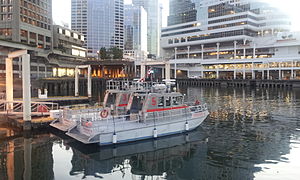Fireboats of Vancouver: Difference between revisions
George Swan (talk | contribs) (more details) |
Pat Palmer (talk | contribs) (adding subpages template) |
||
| Line 1: | Line 1: | ||
{{subpages}} | |||
[[File:Vancouver Fireboats -a.jpg|thumb|Two of Vancouver's five fireboats in 2012.]] | [[File:Vancouver Fireboats -a.jpg|thumb|Two of Vancouver's five fireboats in 2012.]] | ||
The city of [[Vancouver, British Columbia]] has operated [[fireboat]](s) since 1928, when the city introduced the ''[[J.H. Carlisle]].<ref name=Delgado/> The city's second fireboat was a converted [[whale catcher]], formerly the [[Orion (ship, 1904)|''Orion'']], renamed the ''Pluvius'', which only served from 1931 to 1937, before she was scrapped.<ref name=BCShipping2015-11/> | The city of [[Vancouver, British Columbia]] has operated [[fireboat]](s) since 1928, when the city introduced the ''[[J.H. Carlisle]].<ref name=Delgado/> The city's second fireboat was a converted [[whale catcher]], formerly the [[Orion (ship, 1904)|''Orion'']], renamed the ''Pluvius'', which only served from 1931 to 1937, before she was scrapped.<ref name=BCShipping2015-11/> | ||
Revision as of 08:39, 2 September 2022
The city of Vancouver, British Columbia has operated fireboat(s) since 1928, when the city introduced the J.H. Carlisle.[1] The city's second fireboat was a converted whale catcher, formerly the Orion, renamed the Pluvius, which only served from 1931 to 1937, before she was scrapped.[2]
At the time, the shores of False Creek where lined with industrial facilities, mainly sawmills. The owners of these businesses committed to pay for the construction of a fireboat provided it would be stationed in False Creek, as the boat's presence reduced the cost of their fire insurance. The new fireboat was named in honour of Vancouver's longest serving fire chief, John Howe Carlisle.
In 1952 a newly commissioned fireboat, that critics had called a "white elephant" and a "showboat", was able to control a a fire that caused extensive damage.[3]
In 1959 the Norwegian freighter Ferngulf exploded and burned, with two dead and other crewmen seriously wounded, with no intervention by the city's fireboats or other rescue personnel.[4] A city inquiry determined that the city's rules only allowed the fireboat to lave the city when directed to do so by the Mayor.[5] Changes were made to the Canada Shipping Act, empowering a "rescue coordinator", appointed by the Federal Ministry of Transport, to order rescue vessels to sea.
By 2013 the city had owned five smaller fireboats, which had all exceeded their planned fifteen operational life.[6] One of the five has been laid up, while, in December 2013, another out of service vessel had recently been sold. According to 24 hours Vancouver, the existing vessel's had such low pumping capacity that authorities would dispatch two fireboats for each fire. According to 24 hours Vancouver the city is planning to replace all five older vessels with two more powerful vessels. The two new vessels' combined pumping capacity of 13,000 gallons per minute would be approximately three times the total pumping capacity of the current five vessels.
References
- ↑ James P. Delgado. Waterfront: the illustrated maritime history of Greater Vancouver, Vancouver Maritime Museum, p. 118. Retrieved on 2013-12-12. “Vancouver gained its first fireboat in 1928 whenj.H.CorIisle, named forthe city's long-serving fire chief, went into commission on False Creek.”
- ↑ Lea Edgar. Fireboats: A century of marine protection, BC Shipping News, November 2015, p. 20-21. Retrieved on 2017-03-30.
- ↑ $4 Million Fire Hits Vancouver on Waterfront, Oxnard Press Courier, 1952-04-24, p. 2. Retrieved on 2013-12-13.
- ↑ Rescue delay rapped., Spokane Daily Chronicle, 1959-05-02. Retrieved on 2013-12-13.
- ↑ Simma Holt. Rescue Chief Gets Power To Order Fireboat To Sea, Vancouver Sun, 1961-06-20. Retrieved on 2013-12-13.
- ↑ Michael Mui. ‘Rotted’ fireboats need replacing: Vancouver fire department, 24 hours Vancouver, 2013-12-10. Retrieved on 2013-12-12. “One of the older boats has already been sold. Another is placed on reserve, so the department currently only has three fireboats in operation, and Engler described them as having “rotted” hulls and rare replacement parts that have to be custom machined.”
